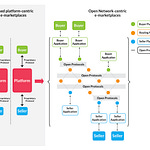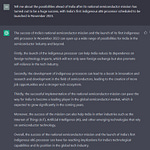CyberPolitik: China’s Norm-game
— Sapni G K
In the 8th edition of this newsletter, I had written about the draft "Internet Information Service Algorithmic Recommendation Management Provisions" released for comments by the Cyberspace Administration of China (CAC). After a few months of deliberations, including their process of public consultation, the draft was finalised this month. The newly released “Internet Information Service Algorithmic Recommendation Management Provisions” lays down rules around the use of algorithmic recommendation technology in internet-based services. This includes a wide range of internet services ranging from social media platforms, gig work platforms, and e-commerce. It could also have potential ramifications on the much-hyped Metaverse and the generative algorithms used in these virtual spaces.
A majority of the principles in the draft version are replicated in the provisions. It is interesting to note that the final version of the provisions has been issued jointly by the Ministry of Industry and Information Technology, the Ministry of Public Security, the competition watchdog State Administration for Market Regulation, and the Cyberspace Administration of China (CAC), where the latter is responsible for overall coordination. The new additions include a provision that bars providers from unreasonable use of algorithms to engage in monopolistic behaviour or restrict other providers, implying a heightened interest in antitrust action through the provisions.
The changes also pertain to giving more attention to “algorithmic fake news”. A new Article 13 mandates licensing for algorithmic recommendation service providers operating in online news and prohibits algorithmic generation of fake news. The elderly have been identified as a new protected category by the provisions. Accordingly, covered providers are required to take special care while providing their services to the elderly. The earlier draft had a clear mandate against the use of discriminatory tags to classify users. However, the provisions have omitted the anti-discriminatory user tag clause. This peculiar change is worthy of attention, given the cons of the vagueness in language as against practices of recommendation algorithm providers to use discriminatory tags.
The provisions are set to be effective from 1 March 2022. Its impact will be visible across services, including independent providers of recommendation algorithm services, who do not have a user-facing business model. Algorithm regulation is a policy issue that cannot be avoided for long. China’s efforts in this sphere can act as an international norm because of its first-mover advantage. The state overtures in these provisions should not guide the baseline for algorithmic regulation. This will be consequential to all players – states, businesses, civil society organisations, and users. Nuanced and informed thought must be employed as regulatory policy is formulated in this sphere, but it must pick up pace.
Matsyanyaaya #1: Why did China just release a National Standardisation Development outline?
— Arjun Gargeyas
(This section is adapted from the Takshashila Issue Paper on China’s Technical Standardisation Framework)
China’s ‘Standards 2035’ project gained headlines in April 2020 at the height of the COVID-19 pandemic. October 2021 saw the release of the National Standardisation Development (NSD) outline document as the first official document detailing China’s ambitions in the coming decade on technical standardisation processes. The NSD visualizes a standardised system that promotes high-tech innovation and “opening up” of the technology sector, while also leading to high-quality development. The core points covered in the document provide a glimpse into the Chinese state’s strategic approach towards technical standards.
But the question is why is the Chinese government pulling out all the stops in the current political climate on its standardisation programme? An analysis of the outline document provides an insight into the State Council’s aspirations in the standard-setting domain and the current objectives of the national technical standardisation strategy. Some key takeaways from the document help us understand the timing and the necessity of the project for the Chinese state.
Standards and Tech Innovation
With the development of critical and emerging technologies, there is a definitive need for the upskilling of technology ecosystems across the world. China feels the need to remain relevant and updated on the usage and creation of applications related to critical technologies. Significant investments in advancing emerging technologies remain one of China’s priorities. The Chinese government now is banking on technical standards to achieve technical competence and excellence in critical technologies which remain integral to the global economy in the coming decades. Gaining technical expertise would in turn help in influencing the standard-setting process allowing China to dictate the terms of technological innovation in certain critical technologies. China feels that it is the ripe time for them, as a technically adept state, to mutually support technological growth as well the ability of Chinese companies to set standards in the domain.
Improving Industrial Standards’ Level
Though a manufacturing powerhouse, China’s exports as a share of GDP have halved over the past decade. This has made the Chinese government understand the importance of establishing norms that govern the systems according to which goods are produced and the flow of these products or services. This is the critical aspect of technical standards which can provide better economic gains in the form of licenses and royalties for the already established manufacturing sector in the country. The Chinese government believes that the strategic and geopolitical game is no longer limited to market domination and is inherently influenced by system design and rulemaking. The standardisation process is essentially the aspect of making global rules according to which industries function. This can facilitate the country’s industrial transformation by acquiring the first-mover advantage in key sectors.
A Base for ‘Green’ Development
Climate goals remain integral to the country’s commitment to following certain sustainable development models. The reason for China’s focus on creating climate-specific standards for local companies to adhere to is in its pursuit to tap into the renewable energy sector. With a significant head start compared to other countries, China has successfully captured the renewable energy market being the global leader in solar, EV batteries, and nuclear power. The threat of climate change looms large which makes the renewable energy markets an economic opportunity for a country like China. Technical standards in the realm are just a way of controlling the extremely lucrative renewable energy markets. China sees the 2020s as an opportune time for driving a robust green energy infrastructure-led growth model which would eventually help them capture market space in the domain. Technical standards related to climate reinforce both China’s commitment towards ‘green development’ as well as use that development as leverage for geoeconomic gains.
With different objectives in mind, the government’s recent ‘National Standardisation Development’ outline has officially kicked off the ambitious ‘Standards 2035’ project of China. It remains to be seen if they are actually successful in their attempt to control the global technical standards domain.
Antriksh Matters: NATO’s Vision for Space
— Aditya Pareek
The North Atlantic Treaty Organisation(NATO) recently published its aptly titled “overarching space policy”. The most striking feature of the policy is its consistency with other familiar aspects of NATO. Below are some distilled highlights of the text:
The policy declares that NATO doesn’t wish “to become an autonomous space actor”, meaning, it will be heavily reliant on the national space programmes of its constituent members. This mirrors the alliance’s stance in other domains and theatres, where the personnel and equipment used by NATO comes directly from the forces of its members.
Another important point is the emphasis on the voluntary nature of capabilities that NATO members may provide for the alliance’s operations in space. Furthermore, the voluntary provision of these capabilities would be in line with the granting state’s “national laws, regulations and policies”.
The policy declares that NATO wishes to serve as the platform for “political-military consultations” related to the alliance’s mandate on “relevant deterrence and defence related space developments”. The goal behind it being the facilitation of “information sharing” between the members so that NATO’s combined “situational awareness”, “decision making”, and “readiness and posture management” can be handled well.
The point about ensuring that NATO’s concerns about space are relevant “across the spectrum of conflict” also signals that NATO wisely considers space to be just one part of wider strategic context.
Another point to note is the stated intention to engage with other international fora and organisations on “the development of legal and behavioural norms”. This is doubtless a reference to various UN General Assembly resolutions, and a newly constituted Open Ended Working Group(OEWG) aimed at figuring out the rules of the road for responsible behaviour in outer space.
It is interesting that the policy also insists NATO members should work towards developing a common understanding of concepts related to the role of space in crisis or conflict. Another focus of the policy is considering “ways to improve space resilience”. This would undoubtedly extend to satellites and other space objects that may provide ISR (Intelligence, Search and Reconnaissance) capabilities to members of the alliance. The policy states that the desired reliability which may enable this resilience would be achieved through “exploiting force multiplier redundancies”.
Matsyanyaaya #2: Over thinking China’s foray into ‘Mind Control’ technologies
— Ruturaj Gowaikar
Current Affair
The year 2021 didn’t end on a pleasant note for two dozen Chinese private technology companies and a dozen government research institutes. These entities were blacklisted and sanctioned by the US for alleged involvement in research related to mind control technologies. Notable among these is the Academy of Military Medical Sciences (AMMS). As per US news reports these technologies were being developed with China’s ethnic minorities in mind but could also be easily deployed abroad. These sanctions are aimed at preventing any technology being developed in the US to be exported to these blacklisted Chinese entities as well as to restrict their funding.
But none of the reports clearly mention what these technologies could be. Most of the private firms are involved in facial recognition and AI based research. These can be easily used for surveillance but lack any mind-control elements. The government research institutes seem to be involved primarily in biotechnology research. There are two possible explanations that might have led to the clubbing of these entities together into a black-list. And that could be the way research is planned and regulated in China.
The broader philosophy of Civil-Military fusion in technology development, adopted by the PLA is part of a national strategy to leverage academic and commercial developments. And the creation of the CMC steering committee on Military Scientific Research handling both research related to biotechnology and brain-machine interface.
The bogey of China possessing mind-control weapons was raised previously in 2019 and might be raised again for political reasons. There exists a lot of confusion regarding the nature of research involved in this domain. Recent developments are cause for us to consider the types of research in the field of neuroscience and their military applications.
Neuroscience research or can be broadly classified into three areas.
1) Assessment technologies
(Imaging -fMRI, electrophysiological recordings, genetics)
2) Interventional Technologies
i) Performance enhancement
Better sensory perception, control over sleep patterns, faster cognition etc
(chemical/biological entities, Brain machine interfaces (BMI), brain
Stimulation, brain implants)
ii) Performance degradation
Loss of consciousness , sedation, hallucination, incoherence, paralysis,
disorientation etc
(chemical/biological entities, electromagnetic/energy )
iii) Delivery systems
Microbes, nanoprobes, direct contact
3) Ethical dialogs and frameworks
Side effects, dependency, dual use nature of technologies
Interventional technologies are the most sought after by the militaries of the world as they can be either used to improve the cognitive performance of one’s own soldiers or degrade the performance of the enemy. There are several challenges in both these sub-fields. The major one in the neuro-enhancement research is the possibility of dependence and withdrawal in case of chemical agents. And in the case of a cortical stimulation devices, there is the large time requirement to customise such a device for an individual operator. Efficient delivery mechanism remains a major challenge for neuro-degradation technology.
The only confirmed product developed by China that can fall under the above classification so far is by the now black-listed AMMS. It is a chemical named Night Eagle that can suppress sleep for 72 hours. Various militaries have dabbled in such chemicals to give an edge to their armed forces. Others are likely to explore this field further.
Our Reading Menu
[Essay Collection] Getting the Multi-domain Challenge Right Edited by Brad Roberts from Center for Global Security Research, Lawrence Livermore National Laboratory.
[Article] The remnants of diplomacy: how Moscow and Washington are fighting "Russian hackers" by Oleg Shakirov.
[Article] The COVID-19 pandemic: territorial, political and governance dimensions of the crisis by Klaus Dodds.













Share this post